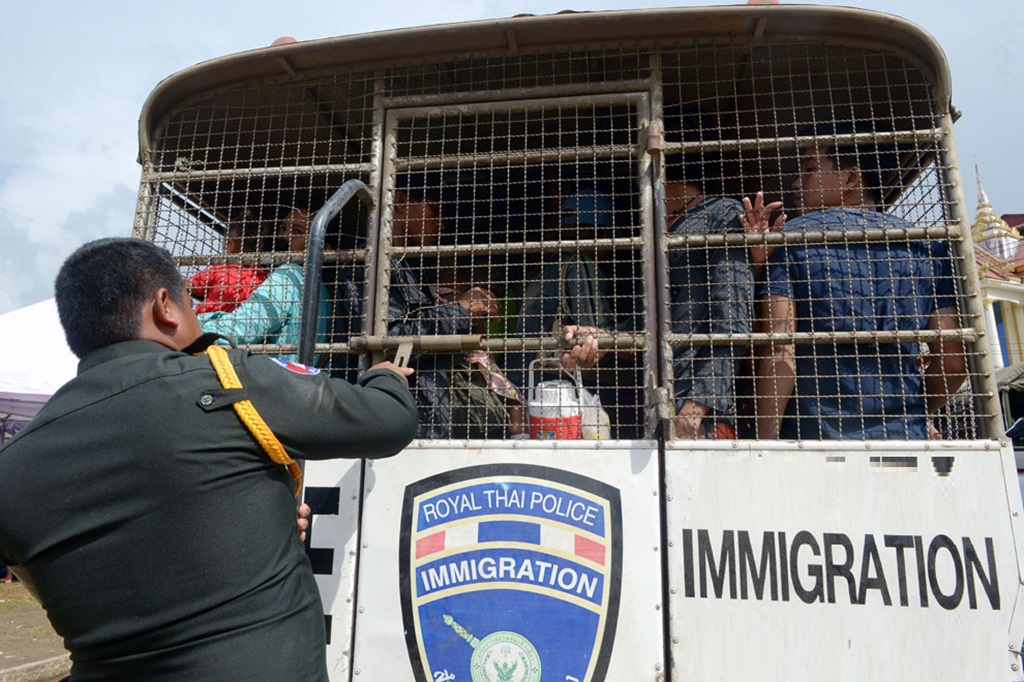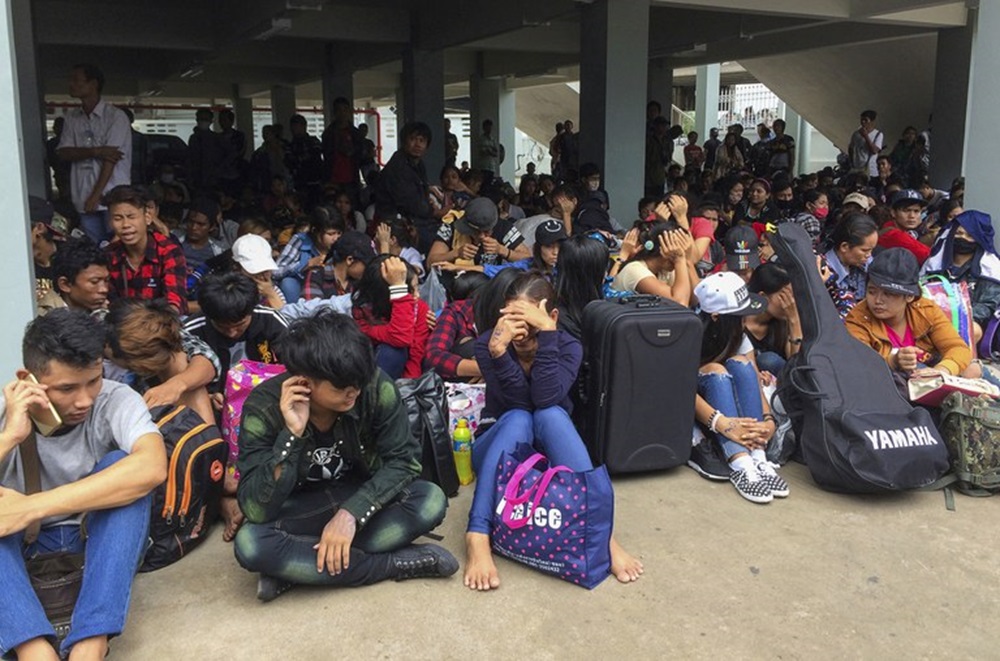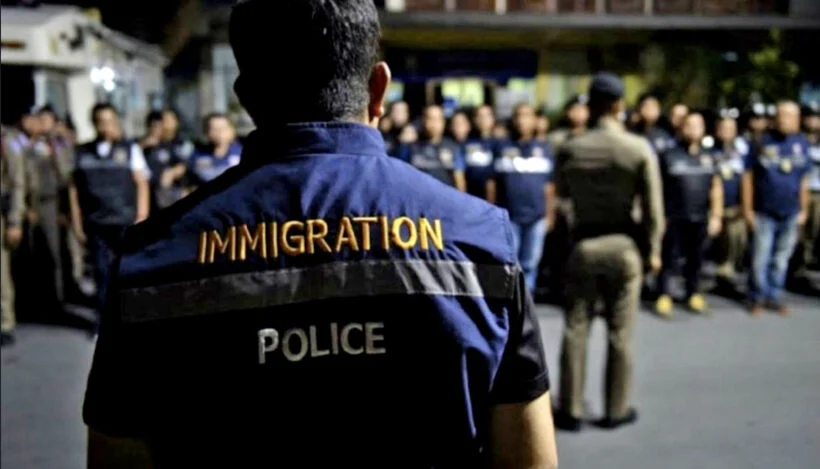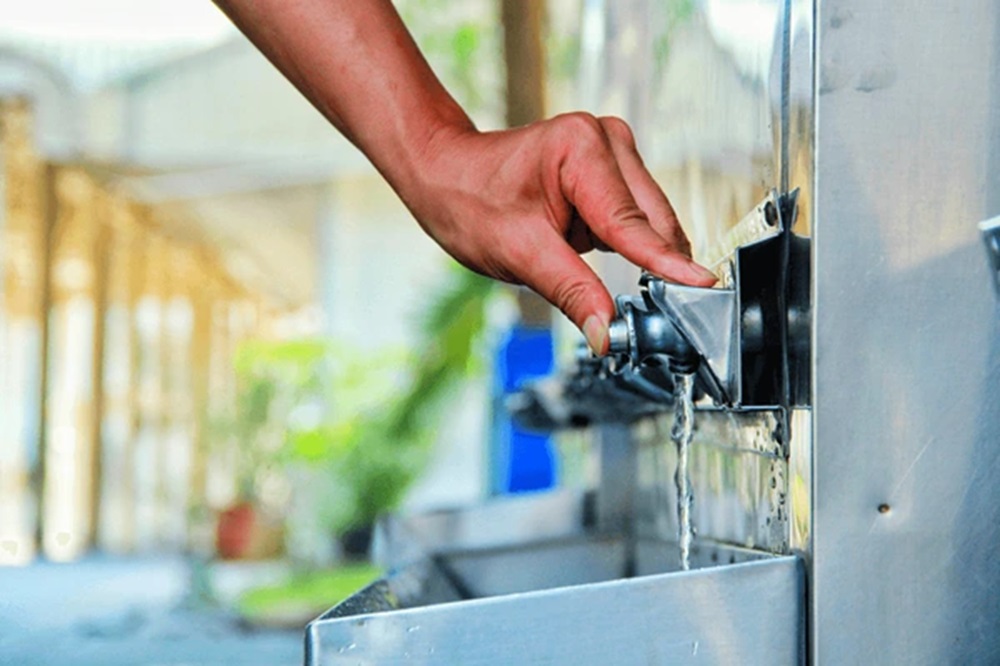Regional News
Police Hunt for Suspect in Yellow Shirt Caught on CCTV Surveillance over Bangkok Bombing

The suspect, wearing a yellow T-shirt and thick-rimmed glasses, was seen carrying a rucksack (left) near the Erawan Shrine
.
.
BANGKOK – Police Lt. Gen. Prawut Thavornsiri, a police spokesman, said Tuesday investigators believe a man seen in security video wearing a yellow T-shirt and carrying a backpack set off the explosion at a central Bangkok shrine that killed 20 people and injured more than 100.
“The yellow shirt guy is not just the suspect. He is the bomber,” Police Lt. Gen. Prawut Thavornsiri, said.
Prawut earlier released several photos of the man, with and without the backpack, on a social media platform. The images were apparently taken from closed-circuit video at Erawan shrine on Monday before the central Bangkok bombing. He confirmed that the man is suspected in the bombing when contacted by The Associated Press.
Video footage posted separately on Thai media appeared to show the same man sitting on a bench at the crowded shrine, then taking off the backpack and leaving it behind as he walked away.
Prime Minister Prayuth Chan-ocha called Monday’s explosion at a busy intersection “the worst incident that has ever happened in Thailand,” and he promised to track down those responsible.
“There have been minor bombs or just noise, but this time they aimed for innocent lives,” Prayuth said. “They want to destroy our economy, our tourism.”
Without elaborating about possible perpetrators, the prime minister said Tuesday, “Today we have seen the closed-circuit footage, we saw some suspects, but it wasn’t clear. We have to find them first.”
The improvised explosive device scattered body parts, spattered blood, blasted windows and burned motorbikes to the metal. The explosion went off around 7 p.m. in an upscale area filled with tourists, office workers and shoppers. No one has claimed responsibility.
Bangkok was rocked again Tuesday when another explosive device blew up at a ferry pier, but no one was hurt.
Police Senior Sgt. Maj. Worapong Boonthawee said an explosive device was thrown from the Taksin Bridge and blew up at Sathorn Pier after falling into the Chao Phraya River below. “There is no injury,” he said. Security camera footage shows a sudden blast of water over a walkway at the pier as bystanders run for safety.
Prayuth gave his first televised address since the bombing Tuesday, saying the government will expedite “all investigative efforts to find the perpetrators and bring them to justice.”
Thai authorities identified five victims as Thai and four as Chinese — two of them from Hong Kong — along with two Malaysians and one Singaporean, and said the nationalities of the other eight victims remained unknown.
Defense Minister Prawit Wongsuwan said authorities had no idea an attack had been planned.
“We didn’t know about this ahead of time. We had no intelligence on this attack,” the defense minister said.
Prayuth vowed to “hurry and find the bombers,” though he noted there may be just one perpetrator. Speaking to reporters, he continued what has been a notoriously prickly relationship with the media since the former general took control of the government in a May 2014 coup.
Advertisement
Continue reading the main story
Advertisement
Continue reading the main story
Asked if there were leads on the suspects’ identities, Prayuth bristled, “We are still investigating. The bomb has just exploded — why are you asking now? Do you understand the word investigation? It’s not like they claim responsibility.”
Thailand has seen many violent attacks in recent years, particularly through a more-than-decade-long insurgency by Muslim separatists that has left more than 5,000 dead in the country’s deep south. Those attacks have never extended to the capital, however.
Bangkok has seen politically charged violence over the past decade; the deadliest, in 2010, killed more than 90 over two months and was centered on the same intersection where Monday’s bomb went off. But none of those attacks included a bomb blast that seemed intended to produce mass casualties.
Matthew Wheeler, Southeast Asia security analyst for the International Crisis Group, said the bombing was a “new type of attack for Bangkok” that doesn’t bear the trademarks of typical violence over the past decade from political instability or Muslim separatists.
“It is certainly not like politically motivated attacks we’ve seen in the past which have generally been designed to grab attention but not cause casualties,” Wheeler said, adding that he expected it would have “major ramifications for security in Thailand.”
Early Tuesday morning, investigators surveyed the damage as police and soldiers guarded the area, still littered with shattered glass and other debris. The normally busy intersection that was closed off to traffic and eerily empty aside from onlookers standing behind police tape to take pictures. Barricades were set up outside five-star hotels in the neighborhood and security stopped cars to inspect trunks before letting them pass. The intersection was reopened by midday.
At least 20 people were confirmed dead and 140 injured, according to the Narinthorn emergency medical rescue center.
National chief of police Somyot Poompanmoung said the bomb was made with a pipe wrapped in cloth and weighed 3 kilograms (more than 6 pounds).
It detonated at the Erawan Shrine, which is dedicated to the Hindu god Brahma, but is extremely popular among Thailand’s Buddhists as well as Chinese tourists. Although Thailand is predominantly Buddhist, it has enormous Hindu influence on its religious practices and language.
Bangkok has been relatively peaceful since a military coup ousted a civilian government in May last year after several months of sometimes violent political protests against the previous government.
At the same time, the military government has tightly controlled dissent, arresting hundreds of its opponents and banning protests. Tensions have risen in recent months, with the junta making clear that it may not hold elections until 2017 and wants a constitution that will allow some type of emergency rule to take the place of an elected government.
Stirring the pot has been exiled former Prime Minister Thaksin Shinawatra, who was ousted in a 2006 coup. It was his sister Yingluck Shinawatra who was ousted as prime minister last year.
Last week, Thaksin posted a message on YouTube urging his followers to reject the draft constitution because he said it was undemocratic. The draft charter is supposed to be voted on next month by a special National Reform Council. If it passes, it is supposed to go to a public referendum around January.
The U.S. Embassy in Bangkok issued an emergency message for U.S. citizens, advising them to avoid the shrine’s area. In Washington, State Department spokesman John Kirby expressed deep sympathy to those affected by the Bangkok explosion. He said authorities were still determining whether any Americans were among the victims.
Tourists reacted with concern.
“We didn’t think anything like this could happen in Bangkok,” said Holger Siegle, a German who said he and his newlywed wife had chosen Thailand because it seemed safe. “Our honeymoon and our vacation will go on, but with a very unsafe feeling.”

Regional News
Thai Immigration Police Detain Over 26,000 Illegal Migrant Workers

Thailand’s Immigration Police have detained approximately 26,000 illegal migrant workers from Laos, Myanmar, and Cambodia during an eight-day operation in Bangkok and surrounding regions, according to a Royal Thai Police spokesperson.
Mr Adisorn Keudmeuangkhon of the Bangkok-based Migrant Working Group said the drive was in response to an increasing number of concerns about an influx of illegal migrant labor.
“Some Thai people see that many illegal workers are competing for their job positions in the past few months,” he told me. “That’s why the ministry has to take tougher action.”
Civil strife in Myanmar and the recent implementation of a military conscription have driven thousands of Burmese into Thailand, while severe inflation and limited job opportunities in Laos have also encouraged an influx of workers from that country.
Between June 5 and 12, officials detained and checked 20,111 Myanmar laborers, 1,659 Laotian migrant workers, and 3,971 Cambodian workers, according to the Ministry of Labor.
It marked the start of a 120-day campaign to audit workplaces and arrest unlawful migrant workers, according to the government.

Migrant Workers to be Deported
According to Keudmeuangkhon, undocumented workers face fines ranging from 5,000 to 50,000 Thai baht (US $136 to $1,365), deportation, and a two-year prohibition on re-entering Thailand.
Authorities did not intend to file criminal charges, he claimed.
Authorities raided 1,774 workplaces, according to Moe Gyo, chairman of the Joint Action Committee on Burmese Affairs, which advocates for Myanmar labor rights.
He stated that since the military junta activated conscription, there has been an upsurge in the number of arrests of Myanmar citizens in Thailand who do not have a work permit identity card.
All men aged 18 to 35 and women aged 18 to 27 must serve in the military for at least two years. The first group of 5,000 conscripts summoned by Myanmar’s junta will start duty at the end of this month, military sources told AFP on Monday.
According to Keudmeuangkhon, the bulk of Lao migrant workers in Thailand work as fresh market shopkeepers, restaurant servers, and mall salespeople.
Most people visit Thailand as part of ASEAN’s visa-free policy for tourists, but they stay longer than the 30-day restriction once they find job.
“Employers like to hire Lao migrant workers in the service sector because they can speak fluent Thai,” he told me.

Immigration Police Detain Illegal Migrant Workers
The Thai Cabinet may approve an enhanced program for Thai employers to register their unauthorized foreign workers in July or August. Keudmeuangkhon explained.
Last month, the Thai Ministry of Labor’s Foreign Workers Administration office announced that 268,465 Lao migrant workers were officially working in Thailand.
Baykham Kattiya, Lao Minister of Labor, told Radio Free Asia earlier this month that there are 415,956 migrant workers in other nations, the majority of whom work in Thailand.
According to her, the Lao government believes that over 203,000 persons working outside of the nation lack proper work documents.
However, a Lao official familiar with the labor industry informed Radio Free Asia, a BenarNews-affiliated news station, on June 20 that the number of illegal Lao migrant workers in Thailand and abroad is likely significantly greater.
“They go to other countries as illegal migrant workers through different types of methods – as tourists or students,” said the politician. “Thus, it is hard for the immigration police to collect data on these people.”
Government Officials Responsible for Smuggling in Migrant Workers
Government Officials Responsible for Smuggling in Migrant Workers
News
High School Student Dies After Being Electrocuted By School Water Dispenser

Thailand’s Office of Basic Education Commission has initiated an investigation into the electrocution of a 14-year-old student by a water dispenser in a high school. The event happened at noon on Friday, during the high school’s sports day. The victim was a Grade 8 student.
According to local media in Trang Province, the incident occurred when a teacher instructed the pupil to turn off a water dispenser amid a heavy rain.
According to a witness, the child collapsed while strolling with his friend near a water station. The friend claimed he attempted to assist but was also shocked by electricity.
According to reports, the friend then recovered, left the site, and requested assistance from teachers. A teacher ran to the scene and used a towel to pull the boy away by the ankle. He was taken to the hospital, but it was too late, they claimed.
The event sparked criticism from parents and netizens over school safety, as well as the slow response to aid the young youngster.
Mr. Chainarong Changrua, head of Trang-Krabi’s Secondary Educational Service Area Office, told local media on Sunday that forensic officers from Trang Provincial Police had visited the area. They discovered the blown breaker switch behind the water dispenser, he explained.
The breaker was burned out, thus the authorities assumed the disaster was caused by a short circuit that allowed energy to spill to a neighboring power pole. The student also appeared wet and was not wearing shoes when electrocuted.
According to the Office of Basic Education Commission, a probe team will complete its investigation this week.
The student’s father, Mr Pornchai Thepsuwan, 53, claimed he was saddened when he saw his son’s body. The boy (Wayu), was the youngest of two boys, he explained. He stated that following the tragedy, the school director and staff gave financial assistance to the families.
Mr Pornchai also said he would not seek charges against the institution because he believed it was an accident.
Electrical accidents in Thailand
Electrocution instances in Thailand have increased alarmingly in recent years. Many mishaps occur as a result of improper wiring and inadequate maintenance of electrical systems.
Public locations, such as schools and markets, frequently lack adequate safety precautions, putting individuals in danger. In rural areas, antiquated infrastructure exacerbates the situation, resulting in more frequent and serious events.
Although several high-profile cases have brought these challenges to light, genuine progress has been gradual. Furthermore, the rainy season heightens the likelihood of electrical accidents, as water and exposed wires do not mix well.
The government has made steps to strengthen safety standards, but enforcement is patchy. More education on electrical safety could help to reduce these accidents.
Unfortunately, better infrastructure and tougher rules may have prevented many of these incidents. The loss and injuries caused by electrocution are avoidable, emphasizing the need for immediate action.
Over 200 High School Students Facing Sedition Charges in Thailand
Over 200 High School Students Facing Sedition Charges in Thailand
News
Thailand’s Tourist Police Crackdown on Tourist Scammers in Pattaya

Thailand’s Tourist Police said it is collaborating with embassies from five countries to combat tourist scams and ten criminal gangs in Pattaya. The Tourist Police Bureau, convened a meeting on Thursday Pol Lt Gen Saksira Phuek-am told a press briefing.
Pol Lt Gen Saksira Phuek-am, the Tourist Police bureau commissioner said the participants included ambassadors from South Korea, Ukraine, Russia, India, and Switzerland.
He told the briefing the he had ordered a crackdown on tourist frauds, such as fraudulent or low-quality tour operators and unfair sales of goods and services. Stepped-up operations began on June 19 and will continue until June 25.
He stated that the agency was working with numerous organisations to increase tourists’ confidence in visiting Pattaya.
Gen Saksira spent time on the famed Walking Street speaking with officers on duty and assigned them to seek for members of ten criminal groups known to operate in Pattaya.
Meanwhile, Prime Minister Srettha Thavisin will visit Chon Buri on Saturday to assess the tourism situation. He intends to visit the site of a future Formula One racecourse near Khao Phra Tamnak in Bang Lamung District.
Prime Minister Srettha recently met with Formula One organisers in Italy to examine the potential of including Thailand on the race schedule in the future.
On Sunday, the Prime Minister will pay a visit to Rayong’s U-tapao airport to discuss development on the airport’s land, with the goal of encouraging investment in the Eastern Economic Corridor.
Police Chief Reinstated
In other police news, Pol Gen Torsak Sukvimol has been reinstated as national police chief following the conclusion of an investigation into a highly publicised quarrel, according to Wissanu Krea-ngam, Prime Minister Srettha Thavisin’s counsellor.
Mr Wissanu released the investigation’s findings on Thursday, after the prime minister formed a fact-finding committee chaired by Chatchai Promlert to investigate into the quarrel between Pol Gen Torsak and his deputy, Pol Gen Surachate Hakparn.
The four-month study revealed conflicts and disorder at all levels of the Royal Thai Police, but it was unclear whether these issues arose from a single cause or several causes, according to Mr Wissanu.
The findings revealed that both Pol Gen Torsak and Pol Gen Surachate were involved, with each team contributing to the tensions, he noted.
Mr Wissanu indicated that Pol Gen Surachate was reinstated as deputy national police head on 18 April following his relocation to the Prime Minister’s Office on 20 March. A disciplinary committee was formed to investigate Pol Gen Surachate, and he was ordered temporarily suspended from the police force.
Because there were no further difficulties to explore, it was decided to restore Pol Gen Torsak. He plans to retire on September 30.
On March 20, Mr Srettha abruptly transferred both top police officers to the Prime Minister’s Office in an effort to address the growing schism within the police service.
Kitrat Panphet, Deputy National Police Chief, was subsequently named Acting Police Chief. According to sources, Pol Gen Surachate could face money laundering charges related to online gaming networks.
Source: Bangkok Post
-

 News3 years ago
News3 years agoLet’s Know About Ultra High Net Worth Individual
-
Entertainment2 years ago
Mabelle Prior: The Voice of Hope, Resilience, and Diversity Inspiring Generations
-

 Health4 years ago
Health4 years agoHow Much Ivermectin Should You Take?
-

 Tech2 years ago
Tech2 years agoTop Forex Brokers of 2023: Reviews and Analysis for Successful Trading
-

 Lifestyles3 years ago
Lifestyles3 years agoAries Soulmate Signs
-

 Movies2 years ago
Movies2 years agoWhat Should I Do If Disney Plus Keeps Logging Me Out of TV?
-

 Health3 years ago
Health3 years agoCan I Buy Ivermectin Without A Prescription in the USA?
-

 Learning3 years ago
Learning3 years agoVirtual Numbers: What Are They For?